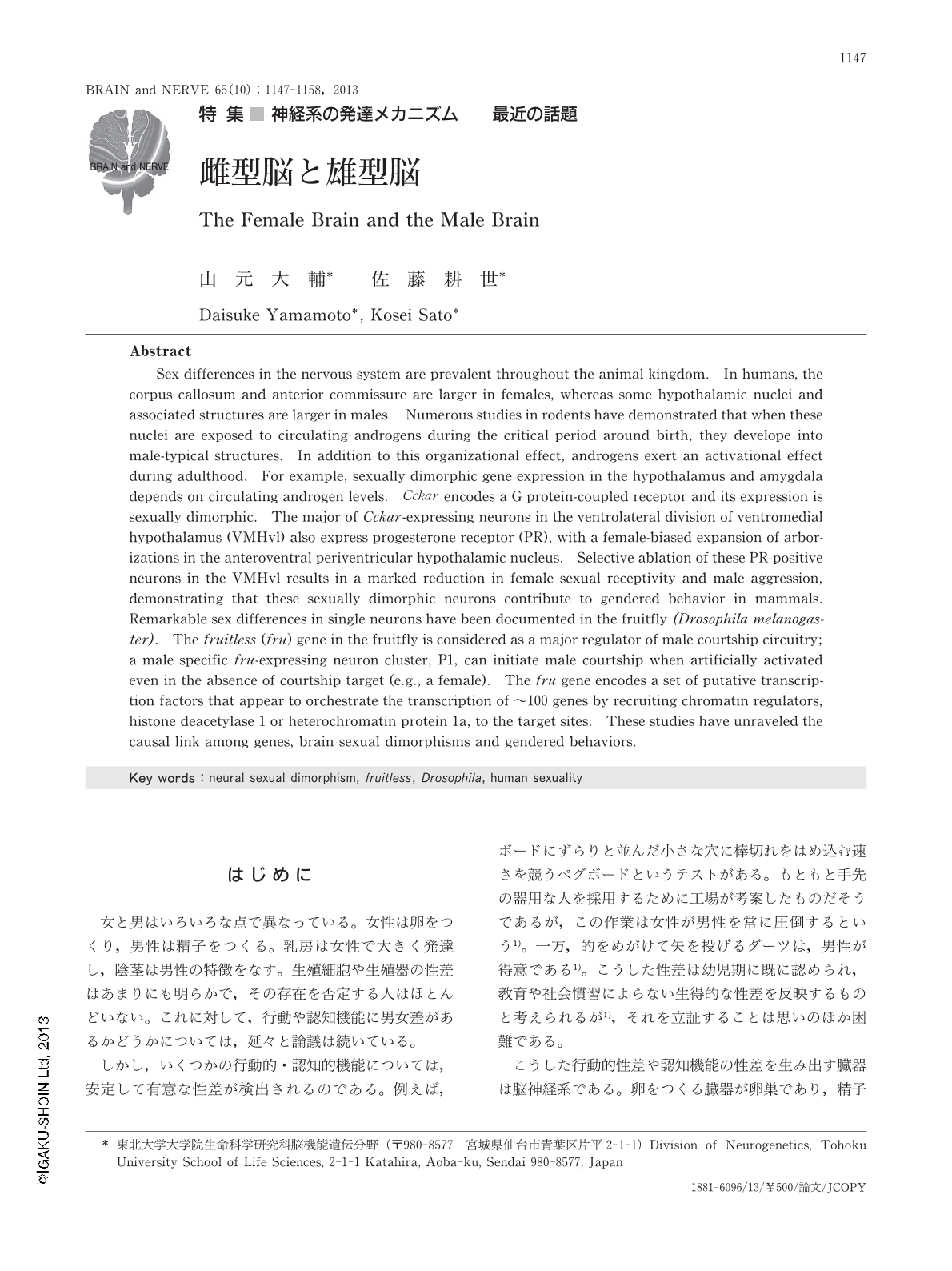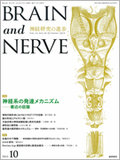Japanese
English
- 有料閲覧
- Abstract 文献概要
- 1ページ目 Look Inside
- 参考文献 Reference
はじめに
女と男はいろいろな点で異なっている。女性は卵をつくり,男性は精子をつくる。乳房は女性で大きく発達し,陰茎は男性の特徴をなす。生殖細胞や生殖器の性差はあまりにも明らかで,その存在を否定する人はほとんどいない。これに対して,行動や認知機能に男女差があるかどうかについては,延々と論議は続いている。
しかし,いくつかの行動的・認知的機能については,安定して有意な性差が検出されるのである。例えば,ボードにずらりと並んだ小さな穴に棒切れをはめ込む速さを競うペグボードというテストがある。もともと手先の器用な人を採用するために工場が考案したものだそうであるが,この作業は女性が男性を常に圧倒するという1)。一方,的をめがけて矢を投げるダーツは,男性が得意である1)。こうした性差は幼児期に既に認められ,教育や社会慣習によらない生得的な性差を反映するものと考えられるが1),それを立証することは思いのほか困難である。
こうした行動的性差や認知機能の性差を生み出す臓器は脳神経系である。卵をつくる臓器が卵巣であり,精子をつくる臓器が精巣であるというのと同じである。卵巣と精巣の違いが極めて顕著であるのに対して,男女の脳に違いがあるのかどうか,これもまた論争的課題であった。少なくとも自然科学の世界では,脳に性差があること自体,今では疑問の余地はなくなっている。しかし,その機能的意味や成因については,いまだ多くが不明である。最近になって,ショウジョウバエやマウスなどのモデル動物を用いた研究から,性的二型を示す個々のニューロンが行動の性差に直接寄与することが明確になり,また,ニューロンの性差を生み出す分子機構の一端が明らかにされるに至っている。
本稿では,ヒト脳の性差の実態,脊椎動物脳の性差とその形成機構,ショウジョウバエの単一ニューロンの性差を生み出す遺伝子機構という3項目を中心に従来の研究を俯瞰し,今後の研究の発展を占うこととしたい。
Abstract
Sex differences in the nervous system are prevalent throughout the animal kingdom. In humans, the corpus callosum and anterior commissure are larger in females, whereas some hypothalamic nuclei and associated structures are larger in males. Numerous studies in rodents have demonstrated that when these nuclei are exposed to circulating androgens during the critical period around birth, they develope into male-typical structures. In addition to this organizational effect, androgens exert an activational effect during adulthood. For example, sexually dimorphic gene expression in the hypothalamus and amygdala depends on circulating androgen levels. Cckar encodes a G protein-coupled receptor and its expression is sexually dimorphic. The major of Cckar-expressing neurons in the ventrolateral division of ventromedial hypothalamus (VMHvl) also express progesterone receptor (PR), with a female-biased expansion of arborizations in the anteroventral periventricular hypothalamic nucleus. Selective ablation of these PR-positive neurons in the VMHvl results in a marked reduction in female sexual receptivity and male aggression, demonstrating that these sexually dimorphic neurons contribute to gendered behavior in mammals. Remarkable sex differences in single neurons have been documented in the fruitfly (Drosophila melanogaster). The fruitless (fru) gene in the fruitfly is considered as a major regulator of male courtship circuitry; a male specific fru-expressing neuron cluster, P1, can initiate male courtship when artificially activated even in the absence of courtship target (e.g., a female). The fru gene encodes a set of putative transcription factors that appear to orchestrate the transcription of ~100 genes by recruiting chromatin regulators, histone deacetylase 1 or heterochromatin protein 1a, to the target sites. These studies have unraveled the causal link among genes, brain sexual dimorphisms and gendered behaviors.

Copyright © 2013, Igaku-Shoin Ltd. All rights reserved.


